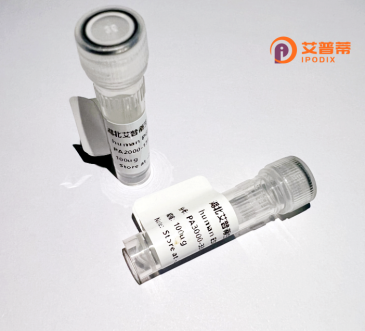
| 纯度 | >90%SDS-PAGE. |
| 种属 | Human |
| 靶点 | RNF26 |
| Uniprot No | Q9BY78 |
| 内毒素 | < 0.01EU/μg |
| 表达宿主 | E.coli |
| 表达区间 | 1-433 aa |
| 活性数据 | MEAVYLVVNGLGLVLDVLTLVLDLNFLLVSSLLASLAWLLAFVYNLPHTVLTSLLHLGRGVLLSLLALIEAVVRFTCGGLQALCTLLYSCCSGLESLKLLGHLASHGALRSREILHRGVLNVVSSGHALLRQACDICAIAMSLVAYVINSLVNICLIGTQNLFSLVLALWDAVTGPLWRMTDVVAAFLAHISSSAVAMAILLWTPCQLALELLASAARLLASFVLVNLTGLVLLACVLAVTVTVLHPDFTLRLATQALSQLHARPSYHRLREDVMRLSRLALGSEAWRRVWSRSLQLASWPNRGGAPGAPQGDPMRVFSVRTRRQDTLPEAGRRSEAEEEEARTIRVTPVRGRERLNEEEPPGGQDPWKLLKEQEERKKCVICQDQSKTVLLLPCRHLCLCQACTEILMRHPVYHRNCPLCRRGILQTLNVYL |
| 分子量 | 74.1 kDa |
| 蛋白标签 | GST-tag at N-terminal |
| 缓冲液 | PBS, pH7.4, containing 0.01% SKL, 1mM DTT, 5% Trehalose and Proclin300. |
| 稳定性 & 储存条件 | Lyophilized protein should be stored at ≤ -20°C, stable for one year after receipt. Reconstituted protein solution can be stored at 2-8°C for 2-7 days. Aliquots of reconstituted samples are stable at ≤ -20°C for 3 months. |
| 复溶 | Always centrifuge tubes before opening.Do not mix by vortex or pipetting. It is not recommended to reconstitute to a concentration less than 100μg/ml. Dissolve the lyophilized protein in distilled water. Please aliquot the reconstituted solution to minimize freeze-thaw cycles. |
以下是3篇关于RNF26蛋白的参考文献及简要摘要:
---
1. **文献名称**:*RNF26 coordinates the sorting of ubiquitylated membrane proteins for lysosomal degradation*
**作者**:Yin Y, et al.
**摘要**:RNF26作为E3泛素连接酶,通过调控泛素依赖的内体分选过程,促进泛素化膜蛋白(如TLR、STING)向溶酶体的靶向运输,影响细胞膜系统稳态和信号通路的时空调控。
---
2. **文献名称**:*RNF26 modulates innate immune signaling by regulating STING trafficking*
**作者**:Liang Q, et al.
**摘要**:研究发现RNF26通过泛素化修饰STING蛋白,控制其从内质网到高尔基体的转运,进而调节cGAS-STING通路介导的I型干扰素反应,揭示其在抗病毒免疫中的关键作用。
---
3. **文献名称**:*Structural basis of RNF26-mediated ubiquitin chain specificity*
**作者**:Yamano K, et al.
**摘要**:通过解析RNF26的泛素连接酶结构域与其底物的互作机制,阐明RNF26偏好形成K48/K63混合型泛素链的分子基础,为靶向泛素化调控的疾病治疗提供理论依据。
---
**补充说明**:
- RNF26主要参与泛素化依赖的膜运输、免疫调节及压力应答;
- 近年来研究热点集中在与自噬、先天免疫(如STING通路)的交叉调控。
RNF26 (Ring Finger Protein 26) is a member of the E3 ubiquitin ligase family, characterized by a conserved RING (Really Interesting New Gene) domain that confers enzymatic activity for ubiquitination. It is localized to perinuclear regions, particularly associated with the endoplasmic reticulum (ER) and Golgi apparatus, where it plays a regulatory role in membrane trafficking, organelle crosstalk, and cellular stress responses. RNF26 facilitates the attachment of ubiquitin molecules to target proteins, tagging them for proteasomal degradation or modulating their interactions in signaling pathways.
A key feature of RNF26 is its involvement in innate immunity, notably through the ubiquitination of STING (Stimulator of Interferon Genes), a critical mediator of antiviral responses. By stabilizing STING at the ER-Golgi interface, RNF26 fine-tunes type I interferon production during viral infections. Additionally, it regulates autophagosome formation by interacting with autophagy-related proteins, linking protein quality control to stress adaptation.
RNF26’s expression is dynamically regulated under stress conditions, such as nutrient deprivation or pathogen invasion, suggesting its role in maintaining cellular homeostasis. Dysregulation of RNF26 has been implicated in inflammatory diseases, neurodegenerative disorders, and cancer, though mechanistic insights remain under investigation. Current research focuses on deciphering its substrate specificity, spatial-temporal regulation, and therapeutic potential in modulating ubiquitin-dependent pathways. Its unique positioning at organelle membranes underscores its importance as a coordinator of intracellular signaling and trafficking networks.
×